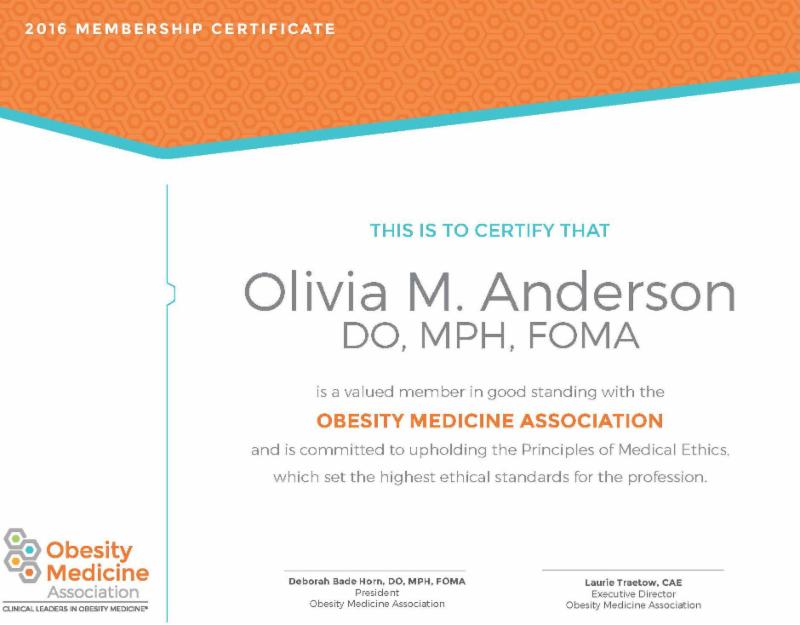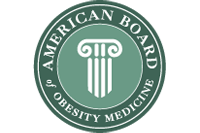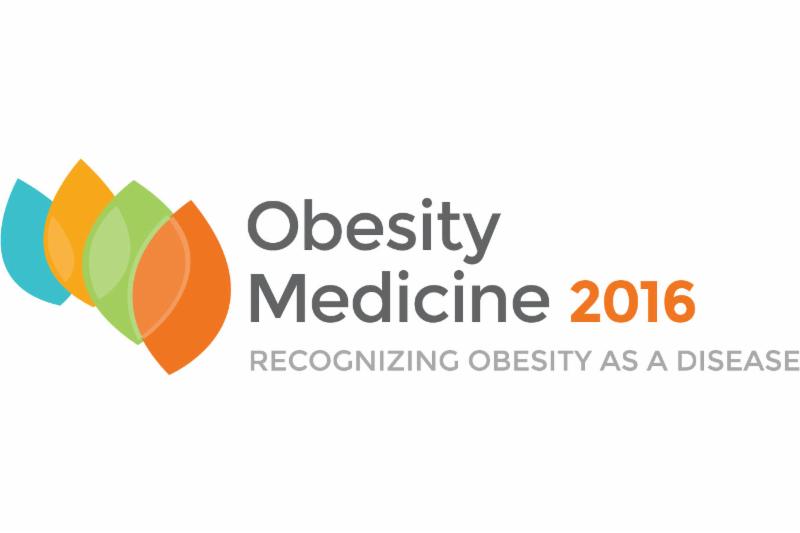 Member certificates are on the way
Your new certificate verifying your membership in OMA is on its way! Watch for your membership packet arriving in the mail in the coming week. Proudly display your membership certificate in your practice to assure your patients that you have the expertise to treat obesity and are committed to making a difference in the lives of your patients. Also included in your membership packet: a magnetic lapel pin to show your colleagues your dedication to the field of obesity medicine. |

Congratulations, new ABOM diplomates!
The American Board of Obesity Medicine (ABOM) recently announced that 419 physicians became newly certified in obesity medicine and 10 physicians re-certified. Forbes published an article praising the growing number of physicians who are recognizing obesity as a disease -- and doing something about it. The new class of diplomates brings the total number of ABOM-certified obesity medicine specialists close to 1,600. Read the full article from Forbes, or read ABOM's announcement to learn more about the record-breaking certification year. |
World Obesity opens late-breaking abstract submissions for ICO 2016
The International Congress on Obesity (ICO) 2016 takes place in Vancouver, British Columbia, on May 1-4. The World Obesity Federation -- one of the organizations hosting ICO 2016 -- opened submissions for late-breaking abstracts for poster presentations until Feb. 15. Late-breaking abstracts will be published online in Obesity Reviews and the conference program. Learn more about submitting a late-breaking abstract for ICO 2016. Remember, as a member of OMA, you receive complimentary membership in the World Obesity Federation. Log in to the member portal, or read the instructions for setting up your portal.
|
 Pediatric obesity committee provides more resources for clinicians
The pediatric obesity committee has an updated webpage on the OMA website to provide you with more resources about treating adolescent patients with obesity. The page includes links to pediatric obesity resources as well as a research article -- to be replaced monthly -- about obesity-related conditions that affect children. Once you've read the article, test your understanding by answering one test question. Each month, you can also find the pediatric-focused research article here as part of your obesity research updates. Read this month's pediatric obesity article in the obesity research updates section of the newsletter. |
 |
 My day on Capitol Hill
Special guest column by Amy Articolo, DO, FACOOG, Dipl. ABOMUpon waking bright and early, we set out to visit with five congressional staff members who represent and are members of the Senate Finance Committee -- the key committee that has jurisdiction over Medicare legislation and the Treat and Reduce Obesity Act (TROA). I have to admit, I was a bit nervous -- I had never done anything like this before. However, it was one of the most memorable days in my career. Chris Gallagher, our Washington representative for the Obesity Care Continuum (OCC), was excellent. He is kind, considerate, resourceful, and patient. He really takes you "under his wing." He organized the entire day, making it an extraordinary experience. I met with legislative correspondents from Senators Cardin (D-MD), Cantwell (D-WA), Menendez (D-NJ), Schumer (D-NY), and Booker's (D-NJ) offices. I was given every opportunity to speak on behalf of OMA, as a physician, and as an obesity medicine specialist. I strongly encourage you, my fellow OMA members, to GET INVOLVED! My experience with the advocacy committee has been very rewarding, and my day on Capitol Hill was nothing less than productive and worthwhile! |
 |
|
|
|
Executive Director
Sponsorships and Exhibits Manager
Operations Manager
Education Coordinator
Communication Manager
Executive Director of the Obesity Treatment Foundation
|
|
101 University Blvd.,
Suite 330
Denver, CO 80206
|
|
|
Breakfast protein source does not influence postprandial appetite response and food intake in normal weight and overweight young women
Crowder, C. M., et al. Journal of Nutrition and Metabolism, 2016.
High-protein breakfasts are touted as being superior to high-carbohydrate breakfasts due to a greater reduction in hunger later in the day. However, the different types of protein (animal versus plant-based) have not been adequately compared. A study was conducted to determine if animal protein consumed at breakfast influences postprandial metabolic responses differently than when plant protein is consumed. The study found that when participants (both those with a normal weight and those with obesity) consumed animal protein at breakfast, they had significantly lower postprandial glucose response compared to when plant protein was consumed. There were no differences observed in appetite or 24-hour food intake in the two conditions. Overall, these data suggest that there may be beneficial effects on glucose control when animal protein is eaten at breakfast. View article
|
Timing of puberty in boys who are overweight versus boys with obesity
Lee, J. M., et al. Pediatrics, 2016.
The effect of excess weight in girls has been known to be associated with earlier onset of puberty; however, the case for boys was not as clear. A study was conducted to determine whether overweight and obesity are associated with differences in the timing of puberty in boys in the United States. The study included boys who were White (49.9 percent, n = 1931), African-American (25.8 percent; n = 1000), or Hispanic (24.3 percent; n = 941) and were in a range of Tanner stages, BMI classifications, and other pubertal variables. Results showed that for White and African-American boys, puberty started earlier in overweight boys compared to normal weight boys, and later in boys with obesity compared to overweight boys, but no significant differences for Hispanics. The study did not investigate the causes of these differences. The authors speculated that an excess of estrogen may delay puberty in the boys with obesity but not overweight. View article
|
Overcoming weight bias in the management of patients with diabetes and obesity
Puhl, R., et al. Clinical Diabetes, 2016.
Weight discrimination is a common occurrence among Americans with obesity. Unfortunately, there is evidence of a significant amount of weight bias even by health care providers, which has been shown to negatively impact the quality of care that individuals with obesity receive. This review article summarizes the evidence for weight bias in a number of areas and discusses the importance of addressing weight bias in clinical care. The authors suggest that there is a great need for increased awareness of this form of bias among health care professionals. View article
|
Pediatric Obesity Research Update
|
|
Pediatric obesity research updates are brought to you by the pediatric obesity committee.
|
The diagnosis of polycystic ovary syndrome in adolescents
Rosenfield, R. L. Pediatrics, 2015.
Polycystic ovary syndrome (PCOS) can be more difficult to diagnosis in adolescents than adults. Although not all adolescent females with obesity have PCOS, and not all females with PCOS have obesity, insulin resistance related to co-existent obesity is the most common non-steroidogenic cause. PCOS runs in families -- about half of sisters are hyperandrogenic and half of those have PCOS. Although physiologic adolescent anovulation is a well-known phenomenon, normal adolescent menstrual cyclicity differs only slightly from normal adult cyclicity; cycles shorter than 19 days or longer than 90 days are abnormal even in adolescents. Even though most cycles in the first post-menarchal year are anovulatory, bleeding usually occurs at 21-45 day intervals. Insulin resistance and obesity are commonly present but not necessarily present, so they are not diagnostic criteria. If insulin resistance and obesity are present, the insulin resistance is often out of proportion to that conferred by the obesity. Metabolic syndrome is present in 25 percent of adolescents with PCOS. The initial workup includes total testosterone, free testosterone, SHBG, DHEAS, and an early morning 17-OH progesterone level. Other labs are individualized. The main considerations in treatment are menstrual irregularity, cutaneous manifestations, and the co-morbidities of metabolic syndrome. Combined oral contraceptive pills are the first line of treatment. Progestin monotherapy may be used alternatively, although it is not as effective at controlling bleeding and suppressing androgens. Weight loss and increased exercise is key. Insulin-lowering treatments may be used in conjunction with lifestyle modification. Well-controlled studies have shown no advantage to metformin over lifestyle modification, but metformin may have an additive benefit if it's used in combination with lifestyle modification. The clear indication for metformin is abnormal glucose tolerance. An early workup for PCOS is encouraged so that a diagnosis can be made prior to initiating treatment. If treatment has been initiated within the first two post-menarchal years, a three-month trial off of OCPs can be attempted when the patient is gynecologically mature to determine the persistence of hyperandrogenic anovulation. Contraceptive counseling should occur at that time because infertility is relative, not absolute.
This review of PCOS in adolescents addresses patients about whom it's always hard to make decisions: those within the first two years post-menarche, and those who were started on OCPs years ago and never had a workup for PCOS. It doesn't discuss fertility issues (most articles about adults spend time on this) because those are usually not an adolescent concern. View article
|
 |

This spring, we're headed to lively San Francisco for Obesity Medicine 2016, your leading resource for certification exam review and the premiere source of education about managing an obesity medicine clinic, nutrition, and the comprehensive approach to obesity treatment. Earn up to 30.5 CME/CE and attend the courses that most interest you!* While you're there, don't miss all that San Francisco has to offer. Take a trip to Alcatraz for a taste of history, walk along the waterfront or the Golden Gate Bridge, or visit one of the city's many cultural districts. |
Review Course for the ABOM Exam
13.25 CME/CE | April 6-7
Helps prepare those planning to take the American Board of Obesity Medicine (ABOM) certification exam.
| Practice Management Essentials
6.5 CME/CE | April 6
Explains the best business practices for running an obesity medicine clinic, from setting up a practice to boosting patient retention.
|
|
Nutrition Course
6.75 CME/CE | April 7
Outlines the latest evidence-based findings about nutrition and helps you select appropriate nutrition plans for your patients.
| Spring Obesity Summit
17.25 CME/CE | April 8-10
Addresses topics related to current and emerging research, evidence-based treatment approaches, technologies, and practical methods used by obesity medicine clinicians.
|
|
|
*The Review Course for the ABOM Exam runs concurrently with Practice Management Essentials on Wednesday and the Nutrition Course on Thursday. Registration for the Review Course includes two days of class time, and switching between courses is not allowed.
|
 There are only two Obesity Medicine Basics courses left this winter. Don't miss your opportunity to either attend this introductory-level course or refer a colleague to attend and earn a $50 Amazon gift card*. Obesity Medicine Basics is worth up to 7 CME/CE hours and provides introductory-level training about the evaluation and treatment of patients affected by obesity. Learn more about this course. Course dates and cities:*For every person you refer who attends an Obesity Medicine Basics course in any city and lists you as the person who referred them, you'll earn a $50 Amazon gift card. |
|
|
|
The Obesity Medicine Association and the Obesity Treatment Foundation thank our 2016 Corporate Advisory Council members for their continuous support.
|
© 2016 Obesity Medicine Association. All rights reserved. Materials may not be reproduced, redistributed or translated without written permission. Advertising disclaimer: Under a policy approved by the OMA executive committee and exhibitor/advertiser review committee, commercial companies may apply to advertise in OMA publications. Approval does not imply endorsement or official recognition of particular products or services.
|
|
|
|